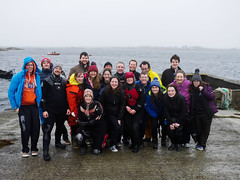BSAC Ocean Diver – overview
Ocean Diver (OD) is the first grade in the BS-AC diving grade sequence, and is considered by BS-AC to be equivalent to the PADI Open Water Diver / Advanced Open Water Diver and CMAS one star diver levels.
An Ocean Diver is a diver who is competent to dive with another Ocean Diver or with a Sports Diver, within the restriction of conditions already encountered during training. HOWEVER as a strict rule in our club only, ODs may only dive with +DL.
They can conduct dives with a Dive Leader (or higher) to expand their experience beyond conditions encountered during training, under the supervision of a Dive Marshal. Ocean Divers are initially restricted to the maximum depth experienced during training, but this can subsequently be extended progressively, under the supervision of a Nationally Qualified Instructor (NQI), to a maximum of 20m using breathing gas of 21%, 32% or 36% O2.
Ocean Divers will not have sufficient experience or knowledge to be partnered with trainee divers or to take part in stage decompression stop dives. Ocean Divers can only conduct dives where other suitably qualified divers, who can act as surface support, are present and the dive is properly marshalled.
Syllabus
The Ocean Diver course consists of:
- 6 Classroom lessons
- Theory assessment
- Basic swimming assessment
- 5 Sheltered water (pool) lessons
- 4 Open water lessons/dives
- minimum of 120 minutes underwater time
To assist preparation for exams you should try out the BSAC online quizzes.
Open water diving should encompass experience of at least four of the following: shelving shore dive, steep shore dive , low (2-4m) visibility dive , drift (0.25-0.5kn) dive, small boat dive, large boat dive, wall dive, dive in protective clothing, dive using Nitrox 32 or 36 on BSAC ’88 air tables.
DUSAC’s Ocean Diver training culminates in the ‘Novice Trip‘.
Lessons
| Lesson type | Lesson | Key components | Links |
|---|---|---|---|
| Theory lessons | OT1: Adapting to the Underwater World |
|
Intro Slides Notes |
| OT2: The body and the effects of diving |
|
Slides Notes |
|
| OT3: Going Diving |
|
Slides Notes |
|
| OT4: Dive Planning |
|
Slides Notes |
|
| OT5: What happens if…? |
|
Slides Notes |
|
| OT6: Enjoying your Diving |
|
Slides Notes |
|
| Theory test | Multiple choice review of lecture course | ||
| Pool lessons | OS1: Being Underwater | Basic equipment (fins, mask, snorkel), scuba, finning, buoyancy, fin pivots, care of equipment | Notes |
| OS2: Basic Skills | Kitting up, buddy checks, swimming on the surface, clearing regulators and mask, using alternate supply, ascending, descending | Notes | |
| OS3: Developing skills | Stride entries, mask clearing, free flows, alternative supply, buoyancy control | Notes | |
| OS4: Beyond the basics | Backward roll entries, descending into deep water, mask clearing, finning without mask, forward rolls, ascents, forward roll entries, surface dives, small boat exits | Notes | |
| OS5: Safety skills | Roll entries, use of alternative supply, towing, controlled buoyant lifts, ladder exits | Notes | |
| Open water lessons | OO1: Open water dive 1 | Max depth 6m – full kit up and buddy check, walk in entries, finning, buoyancy, regulator and partial mask clearing, weight checks | Notes |
| OO2: Open water dive 2 | Max depth 10m – Alternative supply, stuck inflator drills, buoyancy control, inversion recovery, regulator retrieval, mask clearing | Notes | |
| OO3: Open water dive 3 | Max depth 15m –
•Understand how to use an oxygen analyser and record diving-cylinder contents • Be able to safely carry out a near-vertical descent, and maintain good control of their buoyancy throughout the whole dive • Be able to recover an incapacitated diver to the surface and summon help • Be able to jettison an incapacitated diver’s weights/weight belt • Have been introduced to dive-leading skills • Have performed an exit as if into a boat or onto a jetty |
Notes | |
| OO4: Open water dive 4 | Max depth 20m –
• Be able to assemble and check their equipment with minimal supervision • Be able to perform a backward roll entry in full scuba kit • Be able to swim underwater without a mask while breathing from a demand valve • Have developed the ability to manoeuvre in unusual attitudes • Be able to remove the scuba unit at the surface and exit the water as for diving from a small boat • Be able to wash/dismantle their equipment with minimal supervision |
Notes | |
Instructors
All instruction is to be carried out or supervised by a Nationally Qualified Instructor, minimum Open Water Instructor. Other instructor requirements are as follows:
| Grade: | Can instruct: |
|---|---|
| ADI/Sports Diver | Classroom, sheltered water, open water – on site supervision Open water lesson – direct (in-water) supervision |
| ADI/Dive Leader | Classroom, sheltered water, open water – on site supervision |
| Assistant OWI | Classroom, sheltered water, open water – on site supervision |
| Theory Instructor | Classroom – unsupervised |
| Practical Instructor | Sheltered and open water – unsupervised |
| Open Water Instructor | Classroom, sheltered water, open water – unsupervised |
Exams
Theory exams for Ocean Divers are run at various times throughout the year. Keep an eye out for emails from the training officer. To assist preparation for exams you should try out the BSAC online tests.




